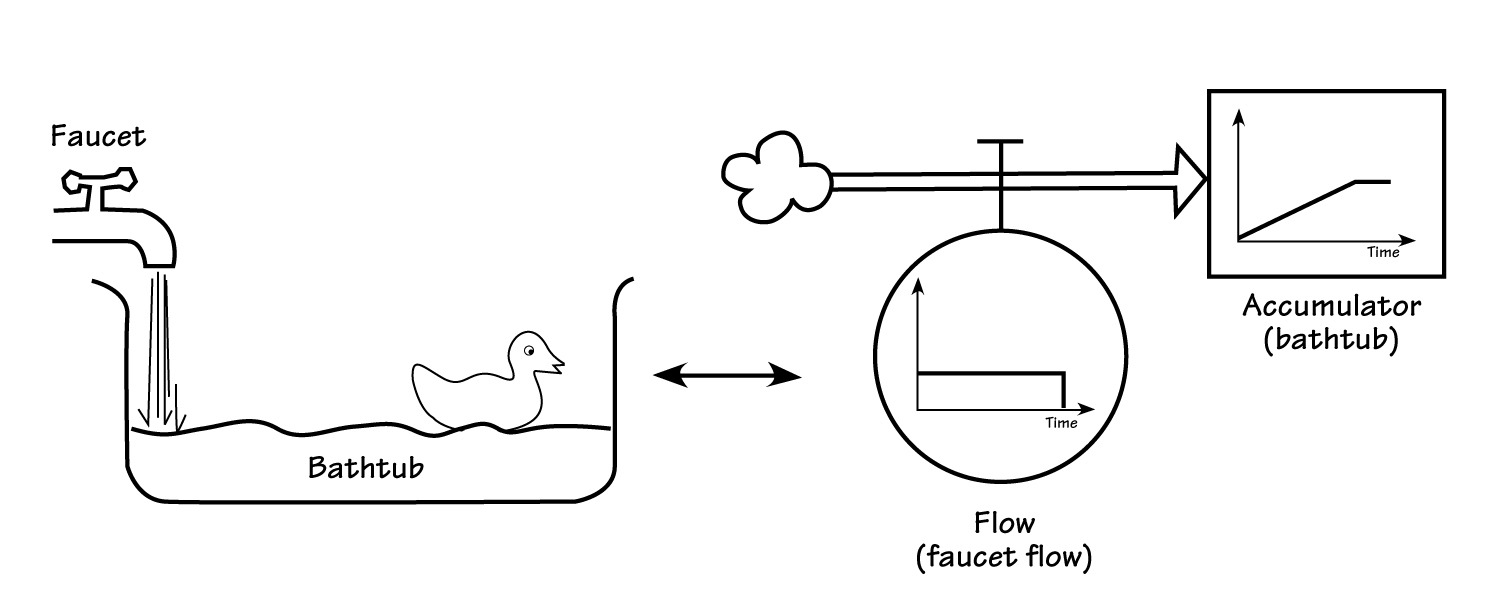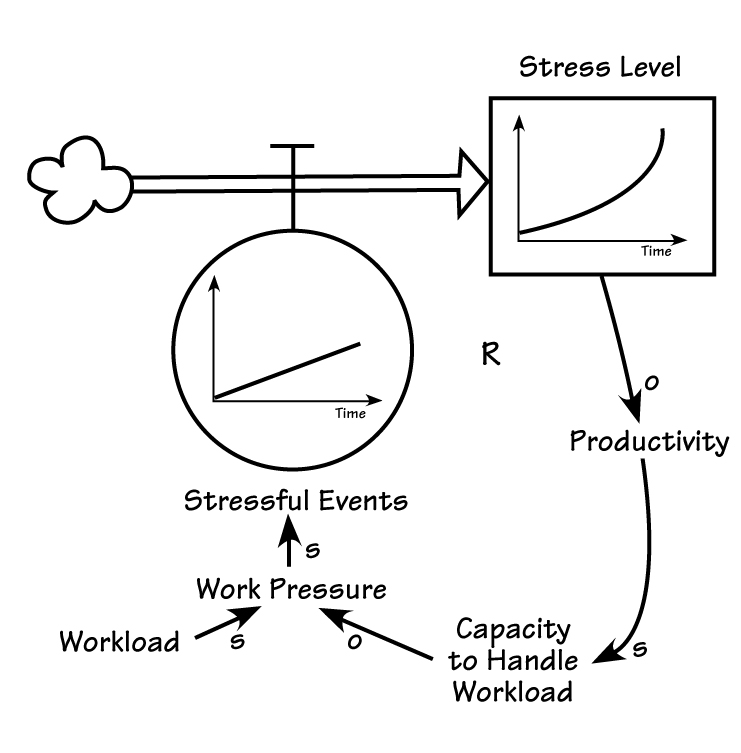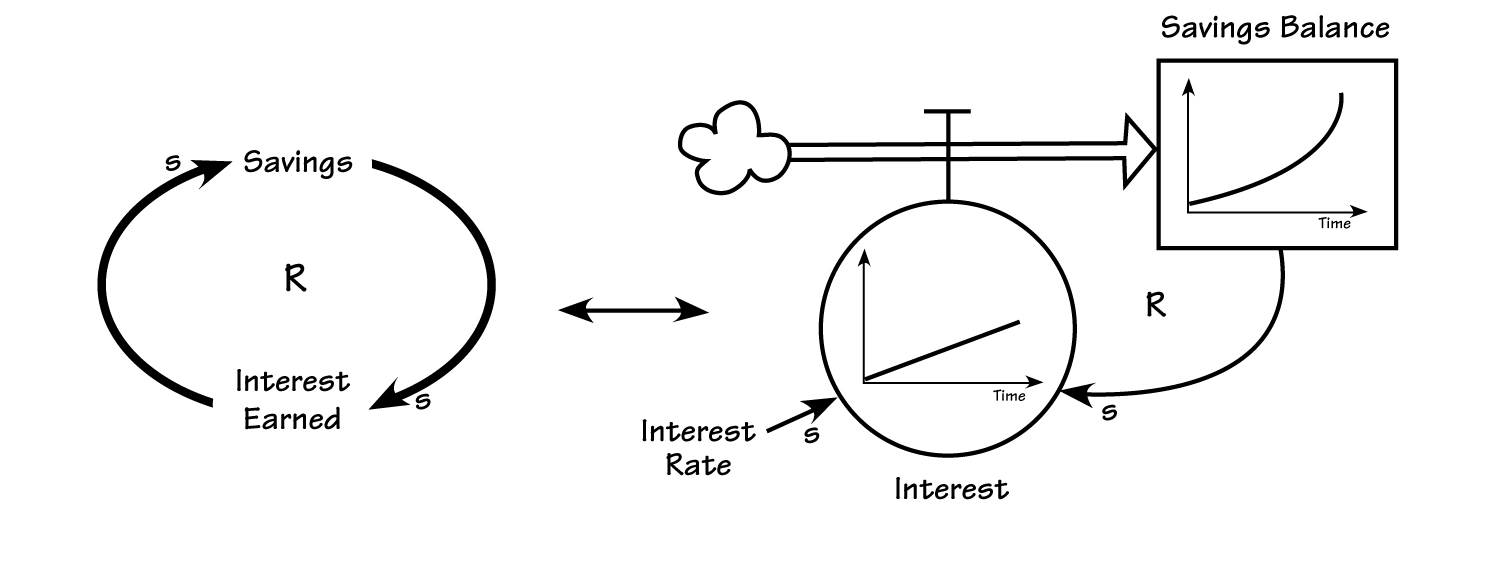When’s the last time you actually took a real, honest-to-goodness bath? If you are like most people, it has probably been quite a while. We live in the world of quick showers and instant breakfasts. Yet, it wasn’t too long ago when taking baths was part of our normal daily routine. The shift from baths to showers marked a far deeper change in our thinking than merely a change in personal hygiene habits.
When we run the bath water, we can visually see the water accumulating in the tub (see “Bathtubs and Accumulators”). We know we have to keep an eye on the water level so it won’t overflow. When we take showers, however, the accumulation process is virtually eliminated. Water flows out of the showerhead, over our bodies, and out the drain. Where does the water go? We hardly give it any thought.
BATHTUBS AND ACCUMULATORS

The core building blocks of dynamic thinking tools are reinforcing and balancing loops. The analogous elements in the structural thinking set of tools are accumulators and flows. An accumulator (or stock) is represented by a rectangular box, and the flow (or rate) is represented by a pipe with a directional arrow, a valve, and a circle. The circle and the box each contain a timeline graph as a visual reminder that the dynamics of the two are intimately connected. For example, the constant flow from the circle to the box as indicated in the diagram must produce the straight linear rise in the water level. No other behavior is possible for that structure as it is drawn.
Showerhead vs. Bathtub Thinking
Taking showers disconnects us from experiencing one of nature’s most basic structures—accumulators. Lakes and ponds are accumulators of various water flows. Global warming has been attributed to the cumulative effects of burning fossil fuels. Plants are accumulators of energy and nutrition. Displacement, velocity, and acceleration can be represented in terms of accumulators. That is, displacement represents the accumulation of past velocity, and velocity is an accumulation of past acceleration.
If we use showerhead thinking, we are less conscious of accumulations. Flows of materials such as water, fuel, or energy simply “go away” somewhere. But from a bathtub—or systems —perspective, there is no “away.” Everything accumulates somewhere. Forgetting about that “somewhere” can lead to disastrous results.
When Just-in-Time (JIT) manufacturing first hit the U. S., for example, many companies implemented it using a showerhead perspective. The basic concept of JIT is to manage a steady flow of materials through a factory with minimal accumulations of inventory at each step. Many companies that instituted JIT tried to minimize their own accumulations by demanding that their suppliers provide them with materials just when they needed them and not any sooner.
The problem with the above approach, of course, is that the flow of materials has to accumulate somewhere, and it was accumulating in the suppliers’ warehouses. The JIT flow was accomplished by shifting the accumulations to suppliers, severely straining the relationship between suppliers and manufacturers. Bathtub thinking would have highlighted the fact that unless the entire flow from raw materials to final customer worked together, there would be undesirable accumulations for somebody in the system.
Invisible Bathtubs
When’s the last time you actually let a bathtub overflow? Probably not in a long time. Of course, we all know not to let the water run indefinitely, because the tub has a limited capacity. The tub’s dimensions are obvious and so is the rising water line. But suppose the bathtub is invisible, and so is the water once it leaves the faucet. And suppose you are not in the bathroom to keep an eye on the tub—you are off answering phone calls and dealing with the latest crisis at the office. How will you know when the bathtub is getting full or already overflowing?
Flows are easy to keep track of because they involve action, and actions are easy to measure—how many products to ship, how many people to hire, for example. Some accumulations are also very visible, such as order backlogs or bulging inventories. There are, however, many accumulations that are not tangible but nonetheless very real. These possess the same behavioral characteristics as physical accumulators and flows, but they are like invisible bathtubs—we can never tell for sure whether they are overflowing or not.
Identifying Accumulations
STRESS ACCUMULATOR

Increasing work pressure can lead to an increased number of stressful events, which adds to the accumulation of stress.
So how can you locate the “invisible bathtubs” lurking in your company? For every flow (action, decision, policy), try to figure out what, if anything, is accumulating and what are the implications of those accumulations.
For example, as workload outstrips capacity and work pressures become excessively high (see “Stress Accumulator”), you should question whether those pressures simply come and go or whether their effects are accumulating somehow. For example, extra pressure may generate more stressful events, which will accumulate into increasing levels of stress. High stress levels will then lead to lower productivity, which further reduces work capacity and leads to more stressful events. This reinforcing loop of accumulating stress is intangible, yet all too real for many people.
If you look at the situation from the accumulator viewpoint and trace out the reinforcing loop, it becomes clear why typical stress reduction efforts do not work very well. Each round of stressful events produces more stress, like compound interest in a savings account. And coping mechanisms are like savings withdrawals—unless you withdraw more than you are earning in interest, the account balance never goes down. Likewise, if the stress “withdrawal” rate (coping mechanisms) are not exceeding the stress “interest” rate (stressful events), then the best you can do is learn to live with the higher stress level. From the accumulator perspective, the high-leverage action would be to “close the account” by reducing or eliminating the real source of stress.
Loop Diagrams vs. Accumulators and Flows
If causal loop diagrams and systems archetypes are such powerful tools, why do we need to bother with accumulators and flows? Both tools have their unique strengths. Tools like systems archetypes capture and communicate dynamic issues in a concise way, but they do not provide a detailed representation of the structure producing the dynamics.
There are cases when tracing through a loop diagram can be confusing. For example:, “Savings and interest form a reinforcing loop where higher savings balance leads to higher interest payments, which leads to still higher savings (see “From Loop Diagrams to Accumulators and Flows”). If we start making withdrawals, the balance goes down and interest payments decrease, but savings does not decrease. It still increases but at a decreased rate.” Sound confusing? That’s where the accumulator and flow diagram can help you actually visualize how that loop works in terms of the flow of money into and out of the account.
FROM LOOP DIAGRAMS TO ACCUMULATORS AND FLOWS

A free market economy is a lot like a seesaw with supply at one end and demand on the other. The dynamics that result from trying to balance supply and demand are produced by two balancing loops that try to stabilize on a particular price. Due to the presence of significant delays, a cycle of overshoot and collapse occurs.
Daniel H. Kim is co-founder of Pegasus Communications, founding publisher of The Systems Thinker newsletter, and a consultant, facilitator, teacher, and public speaker committed to helping problem-solving organizations transform into learning organizations.
